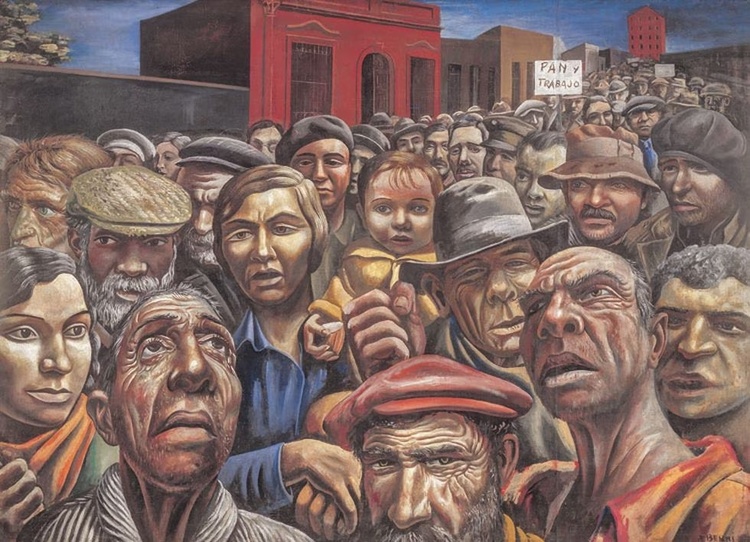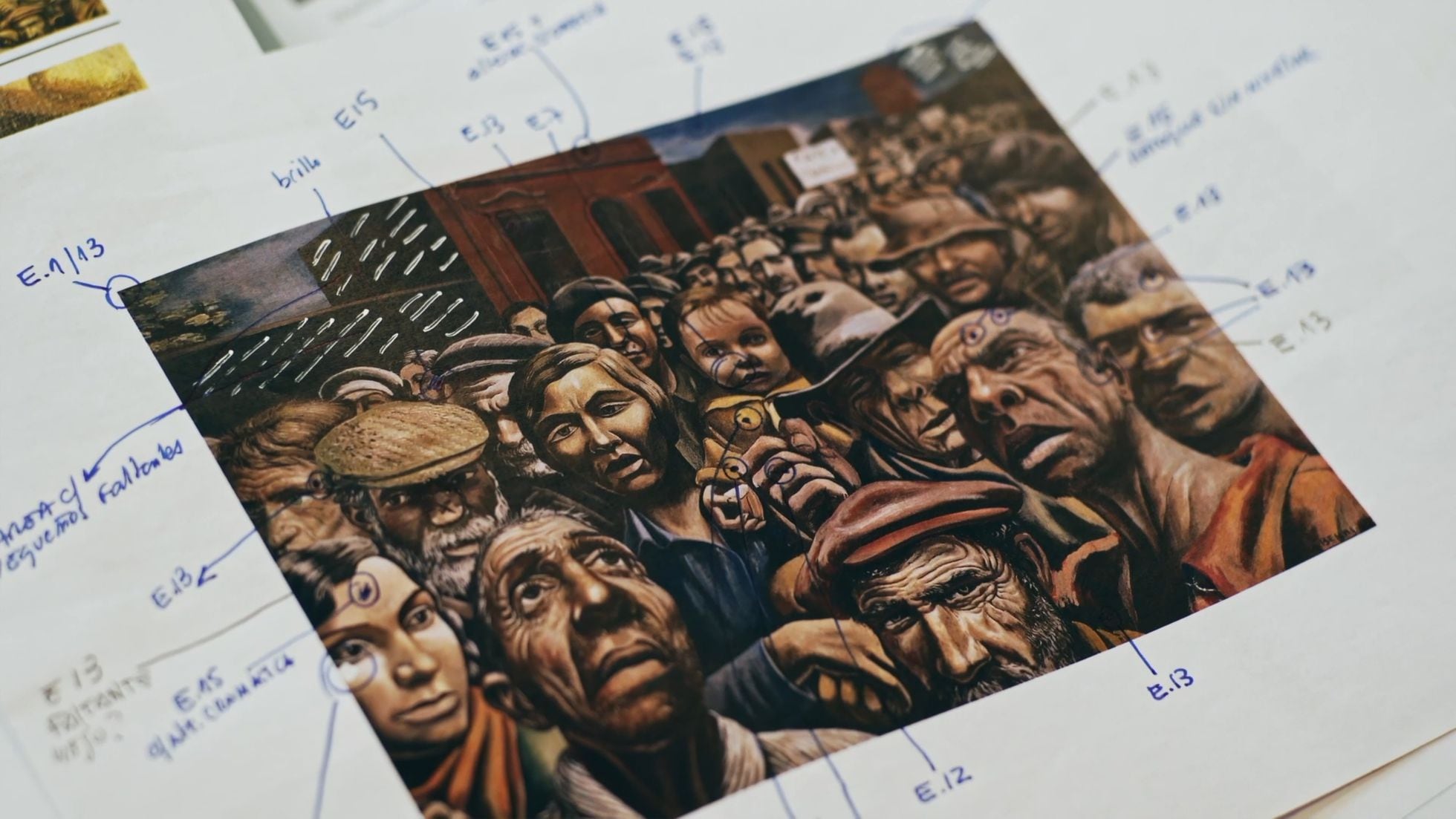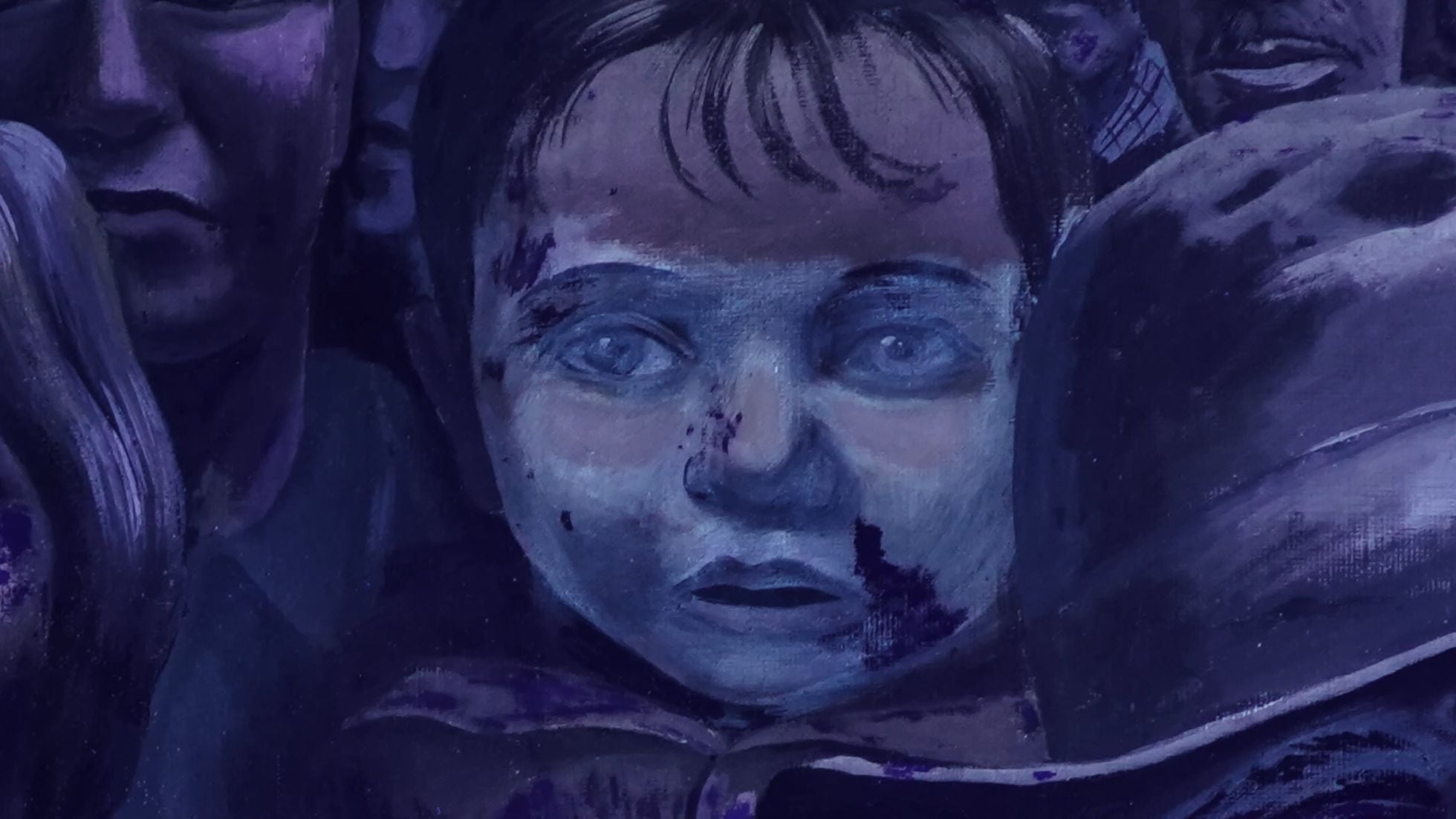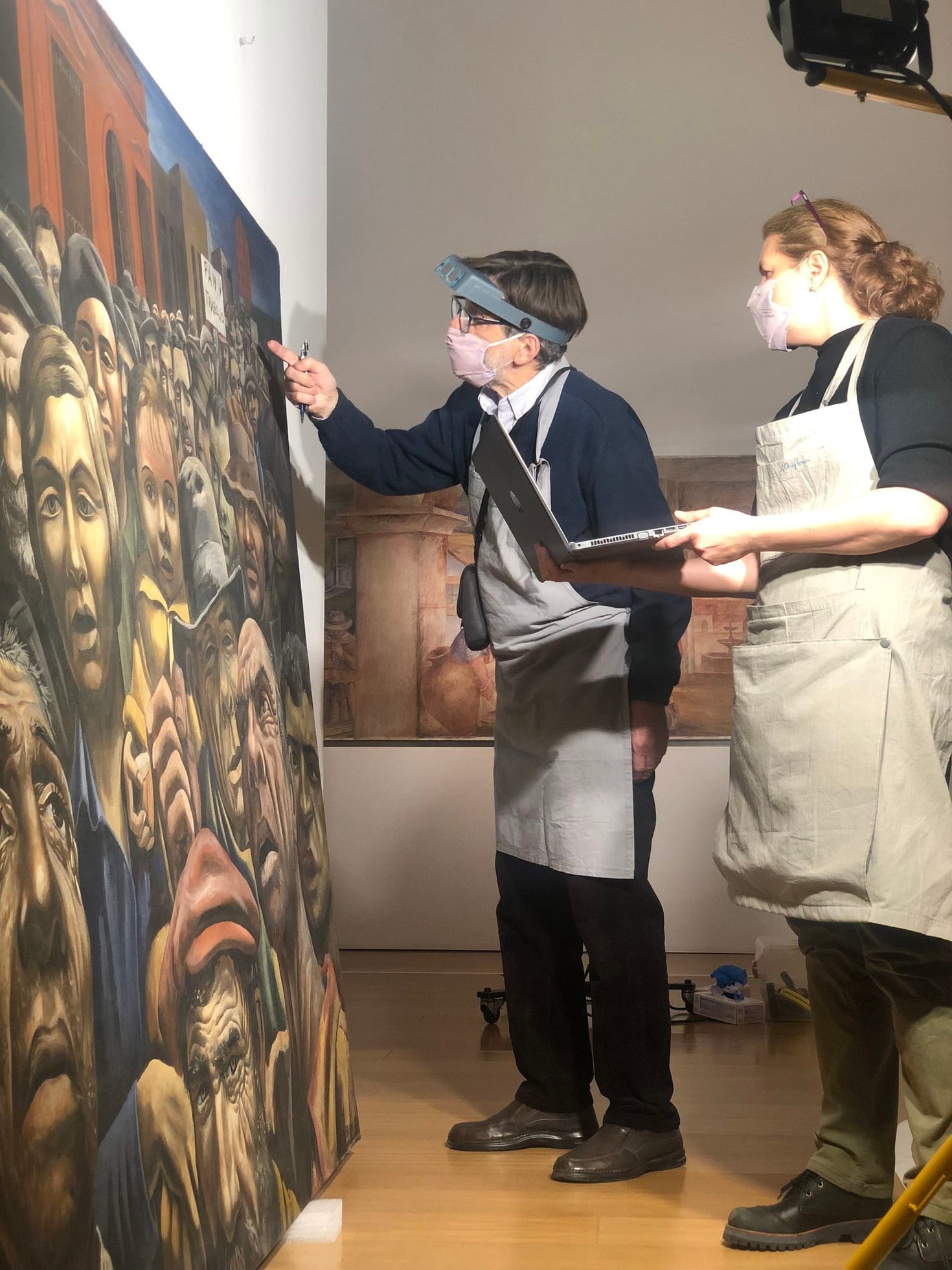
The mystery of the hidden banner in 'Manifestation', the iconic painting by Antonio Berni
The researchers who studied the work, a key to political and social art in Argentina, suspect that the artist sketched a poster that he discarded in the final version of 1934.
The clues were plain to see: a man's raised fist in the center of the painting and a woman's clenched hand in the lower left corner of the painting. The interpretations of the experts who have studied the Manifestation painting, by Antonio Berni, until now pointed out that the first fist symbolizes the strength of that working mass painted by the Argentine artist, while the second is part of "little strange compositional issues" that has the work. But a series of analyzes have revealed the possibility that those closed hands are actually there to hold up a large white sign that the creator painted and eventually concealed under more layers of paint.
The painting, a key work of political and social art in Argentina, has always been analyzed from a historical perspective. Painted after Berni's return from Paris, it is among his emblematic paintings of New Realism and shows, in the foreground, the anguished faces of the workers demonstrating en masse. Studies such as those carried out now by experts from the Museum of Latin American Art of Buenos Aires (Malba) and the University of San Martín had not been applied to this work. The analyzes culminated in 2022 and in August Malba launched an online multimedia project, Manifestación en foco, to disseminate the results obtained after analyzing the material aspects of the work with different techniques.

The specialists wanted to know, for example, what pigments and binders Berni used. It had always been believed that the artist emulsified his pigments with egg, but analysis indicated that he may have done so with animal glue. They also wondered what his work methodology was and discovered that, in the case of Manifestación, Berni first painted a white base, then drew directly on the canvas with charcoal and finally began to give the layers of color. They did not find any sketches of the work, but they were able to identify some of the changes that the artist made during the execution, which were few.
"We thought we had seen all the modifications we were going to see until this great find began to appear," Valeria Intrieri, responsible for managing the Malba collections, told EL PAÍS. The banner, she says, was a "surprise" that came from an X-ray. “He raised it as a very large poster that crosses a large part of the work. There were some indications”, says Intrieri, referring to the fists of those two characters who have their hands closed without holding anything in the final work. "If we look at it now, it was obvious that there had to be something," she says. “What we couldn't find was an inscription,” she says.

Hypothesis about a slogan
Malba researchers are still wondering if there was a message on the banner. Current technology does not show that there has been one, but they do not rule out that in the future the equipment will allow us to see details that are not visible now. The work, in its final version, has a single legible slogan, which calls for "bread and work", and two faded banners in the background of the work. After the crisis of 1929, unemployment and mobilizations were widespread in the world.
The art historian Roberto Amigo, one of the greatest experts on Berni's work, does not believe that there is a text by the artist on the poster raised in the initial composition. However, he proposes hypotheses about what the slogan could have said. "One option is that the banner is an opposition to the Eucharistic Congress, which is central to the discussion at that time," says the researcher. But Amigo chooses to believe that the message may have been related to the post-war hunger marches.
"The clues give us very general orders, such as a demand for work and bread or a call for a general strike," explains the historian, and rules out other options. "I don't think it was a banner of direct reference to the Argentine communist party because at that time the party itself was making a self-criticism of its failure to conquer the proletariat," Amigo maintains. Afterwards he continues: “We cannot see the possibility that he aimed at a class alliance in the fight against fascism because it was not the position of the party in 34″.
The historian points out that Berni's decision to eliminate the cartel was “very early”. With the banner, he says, "the compositional reading would have been different." “The banner would have annulled the perspective that the work has, would have mitigated the helplessness of those faces and would have determined a reading”, he explains. Friend believes that Berni deleted it "because any message posted there was extremely circumstantial": "Not knowing what message or slogan the banner could carry is what allows the power of the painting at different times."

- July 27, 2024
Gallery Of Humor Drawing By Mo Qasem - Netherland

- July 27, 2024
Gallery Of Illustration By Simon Letch - USA

- July 27, 2024
Gallery Of Humor Drawing By George Riemann - Germany

- July 27, 2024
Gallery Of Humor Drawing By Becs - Portugal

- July 26, 2024
Gallery of Humor drawing by Ray Costa - Brazil

- July 26, 2024
Political Cartoons: A Visual Commentary on Society

- July 26, 2024
Olympic spectacle

- July 26, 2024
Gallery of illustration by Per Marquard Otzen - Denmark


- July 26, 2024
Political Cartoons: A Visual Commentary…

- July 25, 2024
Are artificial intelligence and human i…

- July 25, 2024
The contribution of artificial intellig…

- July 23, 2024
Art changes the world

- July 22, 2024
Urban art as a vector for transforming …

- July 22, 2024
Types of Urban Art

- July 13, 2024
ART WITH ARTIFICIAL INTELLIGENCE

- July 13, 2024
The impact of artificial intelligence o…

- July 11, 2024
What is art history and where does it g…

- July 10, 2024
¿Qué es la historia del arte y hacia dó…

- July 08, 2024
Importance of graphic design in society

- July 08, 2024
History of graphic art in Mexico

- July 07, 2024
Can artificial intelligence really crea…

- July 06, 2024
Artificial Intelligence in Digital Phot…

- July 04, 2024
The 5 most visited museums in Brazil

- July 01, 2024
How to create AI art with Adobe Firefly

- July 01, 2024
How to create art with artificial intel…

- June 27, 2024
5 Most Popular AI Image Generators

- June 26, 2024
What are artificial intelligence image …

- June 22, 2024
Artificial Intelligence in Photography

- August 29, 2023
The history of Bolivian art

- January 28, 2024
Culture and Art in Argentina

- February 19, 2024
Analysis and meaning of Van Gogh's Star…

- September 23, 2023
What is paint?

- January 20, 2024
What is the relationship between art an…

- August 16, 2023
The 15 greatest painters in art history

- August 30, 2023
First artistic manifestations

- September 02, 2023
10 famous sculptors from Brazil and the…

- August 08, 2023
Cultural Diversity in Latin American Art

- August 10, 2023
14 questions and answers about the art …

- April 09, 2024
Ziraldo, the legendary figure of Brazil…

- August 22, 2023
Sliman Mansour is a Palestinian painter

- March 25, 2024
The Zaporozhian Cossacks is a painting …

- March 11, 2024
What is the most significant work of ar…

- August 29, 2023
New Logo & Graphic Identity for Helsinki

- October 24, 2023
The art of sculpture in the modern age

- March 30, 2024
The main difference between Picasso and…

- March 30, 2024
history of caricature in latin america

- September 25, 2023
What is the importance of art in human …

- September 23, 2023
Painting characteristics

- August 29, 2023
The history of Bolivian art

- February 19, 2024
Analysis and meaning of Van Gogh's Star…

- August 13, 2023
9 Latino painters and their great contr…

- November 06, 2023
5 Latin American artists and their works

- January 28, 2024
Culture and Art in Argentina

- August 10, 2023
14 questions and answers about the art …

- December 18, 2023
10 iconic works by Oscar Niemeyer, geni…

- September 30, 2023
Outstanding works of sacred art

- October 30, 2023
Characteristics of Contemporary Art

- October 11, 2023
Importance of visual arts at School

- September 29, 2023
Most expensive work auctioned by Fernan…

- September 23, 2023
Painting characteristics

- September 05, 2023
Environmental impacts of Artificial Int…

- December 23, 2023
The 8 Best Museums in Latin America

- January 20, 2024
What is the relationship between art an…

- September 21, 2023
The best poses for drawing

- September 25, 2023
What is the importance of art in human …

- August 08, 2023
Cultural Diversity in Latin American Art

- August 22, 2023
What are Plastic Arts?

- August 27, 2023



